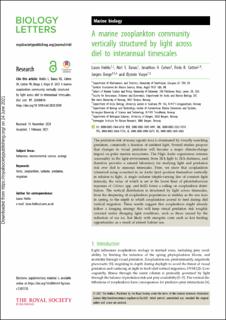| dc.contributor.author | Hobbs, Laura | |
| dc.contributor.author | Banas, Neil S. | |
| dc.contributor.author | Cohen, Jonathan H. | |
| dc.contributor.author | Cottier, Finlo Robert | |
| dc.contributor.author | Berge, Jørgen | |
| dc.contributor.author | Varpe, Øystein | |
| dc.date.accessioned | 2021-08-13T07:12:56Z | |
| dc.date.available | 2021-08-13T07:12:56Z | |
| dc.date.created | 2021-06-22T12:33:58Z | |
| dc.date.issued | 2021 | |
| dc.identifier.issn | 1744-9561 | |
| dc.identifier.uri | https://hdl.handle.net/11250/2767691 | |
| dc.description.abstract | The predation risk of many aquatic taxa is dominated by visually searching predators, commonly a function of ambient light. Several studies propose that changes in visual predation will become a major climate-change impact on polar marine ecosystems. The High Arctic experiences extreme seasonality in the light environment, from 24 h light to 24 h darkness, and therefore provides a natural laboratory for studying light and predation risk over diel to seasonal timescales. Here, we show that zooplankton (observed using acoustics) in an Arctic fjord position themselves vertically in relation to light. A single isolume (depth-varying line of constant light intensity, the value of which is set at the lower limit of photobehaviour reponses of Calanus spp. and krill) forms a ceiling on zooplankton distribution. The vertical distribution is structured by light across timescales, from the deepening of zooplankton populations at midday as the sun rises in spring, to the depth to which zooplankton ascend to feed during diel vertical migration. These results suggest that zooplankton might already follow a foraging strategy that will keep visual predation risk roughly constant under changing light conditions, such as those caused by the reduction of sea ice, but likely with energetic costs such as lost feeding opportunities as a result of altered habitat use. | en_US |
| dc.language.iso | eng | en_US |
| dc.publisher | The Royal Society | en_US |
| dc.rights | Navngivelse 4.0 Internasjonal | * |
| dc.rights.uri | http://creativecommons.org/licenses/by/4.0/deed.no | * |
| dc.title | A marine zooplankton community vertically structured by light across diel to interannual timescales | en_US |
| dc.type | Journal article | en_US |
| dc.type | Peer reviewed | en_US |
| dc.description.version | publishedVersion | en_US |
| dc.rights.holder | Copyright 2021 The Authors. | en_US |
| dc.source.articlenumber | 20200810 | en_US |
| cristin.ispublished | true | |
| cristin.fulltext | original | |
| cristin.qualitycode | 2 | |
| dc.identifier.doi | 10.1098/rsbl.2020.0810 | |
| dc.identifier.cristin | 1917670 | |
| dc.source.journal | Biology Letters | en_US |
| dc.identifier.citation | Biology Letters. 2021, 17 (2), 20200810. | en_US |
| dc.source.volume | 17 | en_US |
| dc.source.issue | 2 | en_US |

